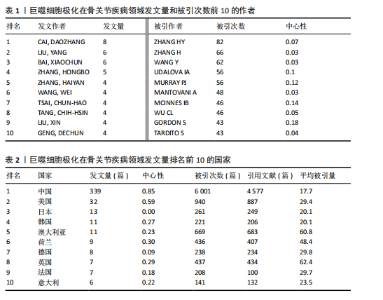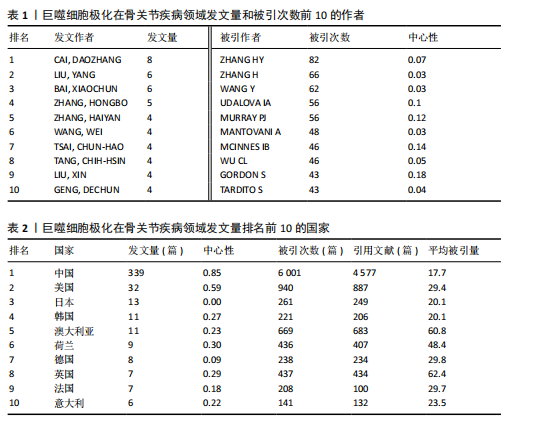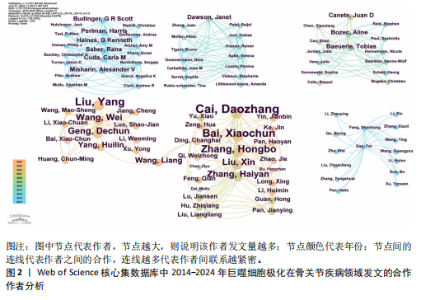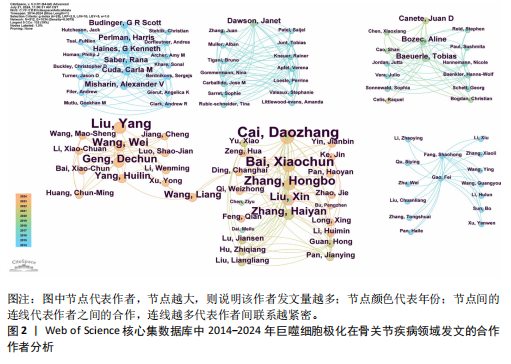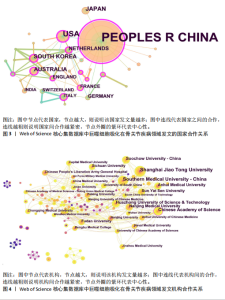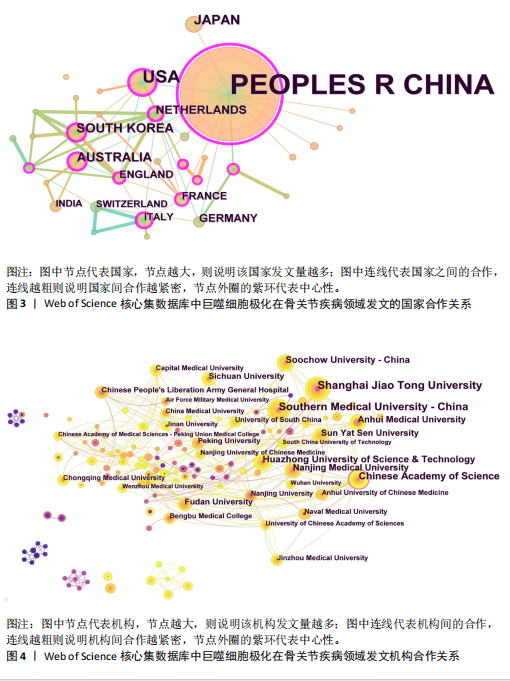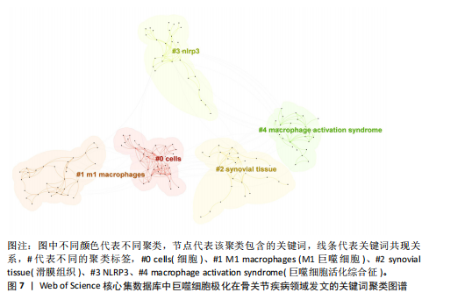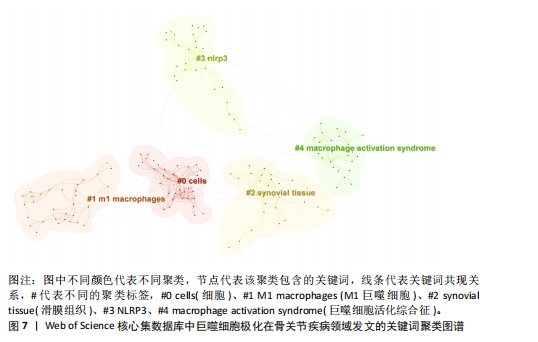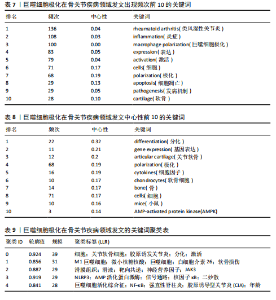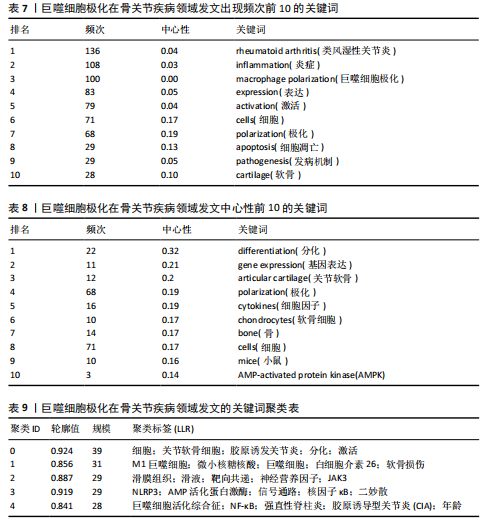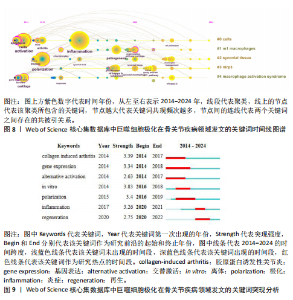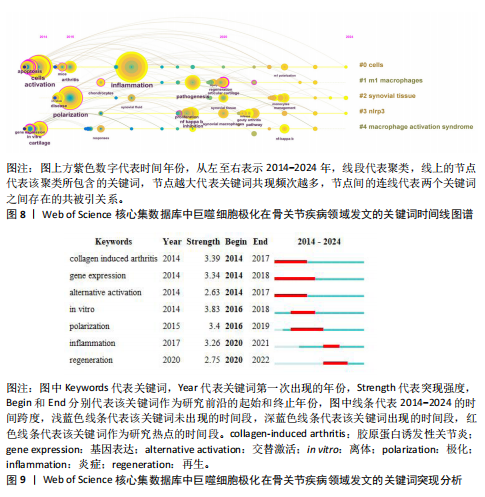Chinese Journal of Tissue Engineering Research ›› 2025, Vol. 29 ›› Issue (24): 5245-5253.doi: 10.12307/2025.720
Previous Articles Next Articles
Involvement of macrophage polarization in osteoarticular diseases: a visual analysis based on SCI-Expanded information
Zou Shunyi1, Chai yuan1, 2, Li Kunjian1
- 1Guangxi University of Chinese Medicine, Nanning 530001, Guangxi Zhuang Autonomous Region, China; 2Department of Orthopedics, Ruikang Hospital, Guangxi University of Chinese Medicine, Nanning 530011, Guangxi Zhuang Autonomous Region, China
-
Received:2024-08-14Accepted:2024-09-26Online:2025-08-28Published:2025-02-06 -
Contact:Cai Yuan, MS, Physician, Guangxi University of Chinese Medicine, Nanning 530001, Guangxi Zhuang Autonomous Region, China;Department of Orthopedics, Ruikang Hospital, Guangxi University of Chinese Medicine, Nanning 530011, Guangxi Zhuang Autonomous Region, China -
About author:Zou Shunyi, Master’s candidate, Guangxi University of Chinese Medicine, Nanning 530001, Guangxi Zhuang Autonomous Region, China -
Supported by:Guangxi University Young and Middle-aged Teachers Scientific Research Basic Ability Improvement Project, No. 2024KY0300 (to CY); Guangxi Traditional Chinese Medicine Appropriate Technology Development and Promotion Project, No. GZSY2024036 (to CY [project participant]); Guangxi University of Traditional Chinese Medicine University-level College Student Innovation Training Program, No. X202410600062 (to CY [project participant]); Guangxi Autonomous Region College Student Innovation Training Program, Nos. S202410600084 and 202410600022 (to CY [project participant])
CLC Number:
Cite this article
Zou Shunyi, Chai yuan, Li Kunjian. Involvement of macrophage polarization in osteoarticular diseases: a visual analysis based on SCI-Expanded information[J]. Chinese Journal of Tissue Engineering Research, 2025, 29(24): 5245-5253.
share this article
Add to citation manager EndNote|Reference Manager|ProCite|BibTeX|RefWorks
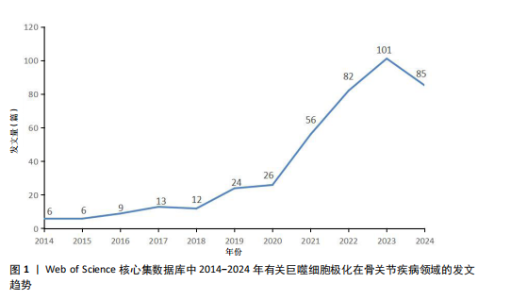
2.1 发文量与发文趋势 共纳入文献420篇,文献引用量为6 964篇,文献被引次数9 360次,平均被引次数22.29次,H值为50,代表至少50篇文献被引用50次[9]。将纳入文献按照出版年份进行统计,因检索日期截至2024-06-01,2024年数据不全面,故2024年发文量不纳入考虑。依据折线图可见,除2018年外,近10年来巨噬细胞极化在骨关节疾病中的发文量总体呈上升趋势。发文量的变化趋势可大致分为2个阶段:第一阶段为2014-2020年,这一阶段发文量的增长速度较为平稳,为缓慢增长期;第二阶段为2021-2023年,这一阶段发文量增长迅速,并且2023年发文量突破100篇,为快速发展期。由此可见巨噬细胞极化在骨关节疾病中的关注度不断增加,有较大的发展潜力,见图1。 2.2 合作作者及作者被引 发文量和被引量前10的作者如表1所示,被引用次数最多的作者是ZHANG HY (82篇),其次是ZHANG H(66篇)和WANG Y(62篇),说明他们的研究有重要影响力,为多数学者所认可。合作作者共现图如图2所示,从发文作者的合作关系上看,合作作者大致形成相互独立的6个团队,其中最大的是以Cai,Daozhang为核心的团队。参与文献发表最多的作者是Cai,Daozhang(8篇),其次是Liu,Yang(6篇)和Bai,Xiaochun(6篇),他们是在此领域相对活跃的作者。 2.3 国家/地区及机构合作网络分析 设置节点为国家(Country),运行Citespace软件,将Taiwan并入Peoples R China后得到国家合作共现图谱(图3),该图共有34个节点,57条连线,密度为0.101 6。纳入文献中共有34个国家,表2列举了发文量前10的国家,其中中国的发文量和中心性远超其他国家,位列第一(339篇,0.85),其次是美国(32篇,0.59)。中国是研究巨噬细胞极化参与骨关节疾病领域的主力军。平均被引次数最高的国家是英国(62.4),其次是澳大利亚(60.8),而中国文献的平均被引次数为17.7,较低于其他国家,见表2。 设置节点为机构(Institution),运行Citespace软件,得到机构合作共现图谱(图4),该图有241个节点,413条连线,密度为0.014 3。发文量排名前10的机构如表3所示,其中发文量最多的机构是上海交通大学(30篇),其次是南方医科大学(27篇)和中国科学院(21篇)。发文量排名前10的机构均来自中国,并且主要是中国的高校。中国各机构的中心性并不突出,中心性≥0.1的机构仅有中国科学院(21篇,0.13)。发文机构共现图如图4所示,可见中国各发文机构之间有相互合作,但是总体合作强度不高,且缺乏与国外机构的交流合作。 2.4 发文期刊和共引期刊分析 利用Web of Science的文献分析功能,统计导入文献发文量前10的期刊(表4)。导入的420篇文献共"
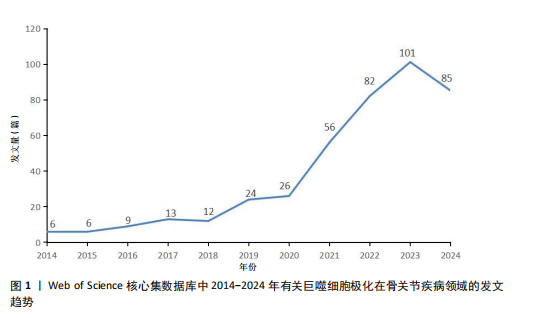
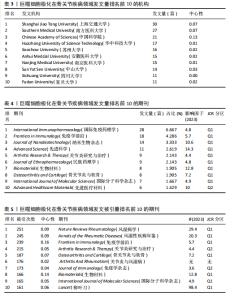
发表在178种期刊上,其中收录文献最多的期刊是《International Immunopharmacology》(28篇),影响因子最高的期刊是《Advanced Science》(14.3)。发文量前10 的期刊平均影响因子为7.95,发文量占文献总量的28.10%。 设置节点为被引期刊(Cited Journal),运行Citespace软件,得到453个节点,2 946条连线,密度为0.028的被引期刊共现图谱(图5)。共引频次前10的期刊如表5所示,除《Arthritis And Rheumatism(关节炎与风湿病)》在2023年未被JCR收录外,其余期刊均被收录。被引次数最多的期刊是《Nature Reviews Rheumatology》(251次)。被引期刊中影响因子最高的期刊是《Lancet》(98.4),是全球最顶尖的综合性医学期刊,在医学界有巨大的影响力。 综合发文期刊和被引期刊分析来看,《Frontiers in Immunology(免疫学前沿)》《Arthritis Research & Therapy (关节炎研究与治疗)》《Osteoarthritis and Cartilage(关节炎与软骨)》和《International Journal of Molecular Sciences(国际分子科学杂志)》在发文量和共引量中均排名前10,是该领域中较有影响力的期刊。 2.5 文献共被引分析 文献共被引分析是Citespace软件最具特色的功能,可以分析文献之间的相互联系,帮助研究者识别该领域的重点文献[10]。对导入文献进行文献共被引分析,被引频次排名前10的文献如表6所示[11-20],其中7篇探讨了巨噬细胞在疾病中的发病机制或治疗潜力,2篇研究了靶向巨噬细胞极化治疗药物的开发,1篇回顾了关节炎的研究现状。共被引频次最多的文献是Macrophages regulate the progression of osteoarthritis (52次,0.07),中心性最高的文献是Macrophage: A Potential Target on Cartilage Regeneration(27次,0.14)。文献共被引关键词聚类中,聚类规模排名前5的聚类标签分别是#0 osteoarthritis(骨关节炎)、#1 rheumatoid arthritis(类风湿性关节炎)、#2 stat3、#3 bone marrow mesenchymal stem cells(骨髓间充质干细胞)、#4 synergistic effect(协同效应)。"
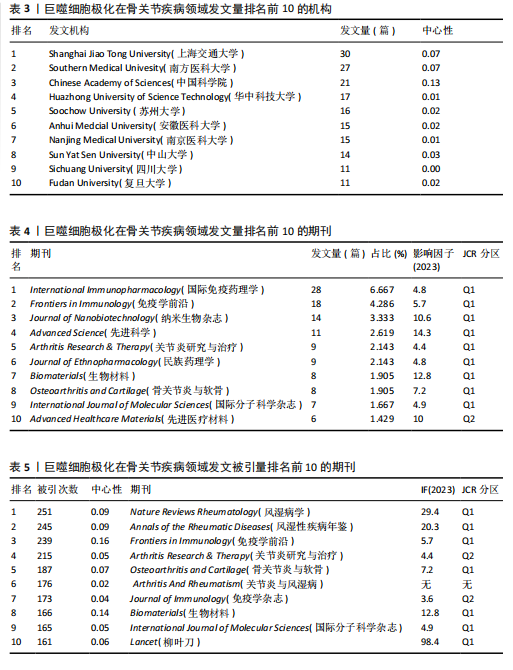
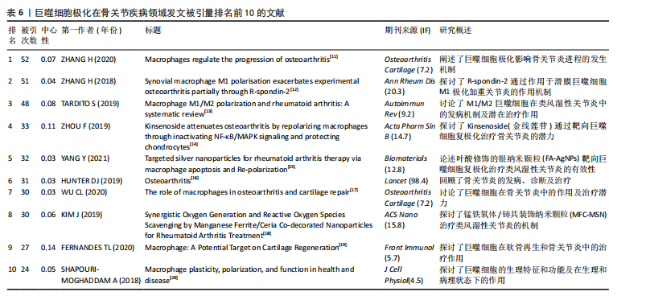
2.6 关键词分析 2.6.1 关键词共现 设置节点为关键词(Keywords),运行Citespace软件,得到节点数为330,连线数为735,密度为0.013 5的关键词共现图谱(图6)。关键词是一篇论文的主题与核心,通过对纳入文献的关键词进行分析,可以更好地把握巨噬细胞极化在骨关节炎领域的研究热点变化[21]。纳入文献中频次最高的关键词为rheumatoid arthritis(类风湿性关节炎)(136次),其次是inflammation(炎症)(108次)和macrophage polarization(巨噬细胞极化)(100次)。中心性最高的关键词是differentiation(分化)(0.32),其次是gene expression(基因表达)(0.21)和articular cartilage(关节软骨)(0.2)。综合关键词出现频次和中心性,并排除与主题直接相关的关键词,可知该领域的核心关键词是:apoptosis(细胞凋亡)、cartilage(软骨)、differentiation(分化)、gene expression(基因表达)、cytokines(细胞因子)。频次和中心性前10的关键词如表7,8所示。 2.6.2 关键词聚类分析 利用Citespace软件对关键词进行聚类并绘制图谱(图7)。聚类序号越小,代表聚类规模越大,聚类包含的关键词就越多。聚类以聚类模块值(Q)和平均轮廓值(S)作为聚类的评判标准。一般认为,聚类模块值(Q) > 0.3可以"
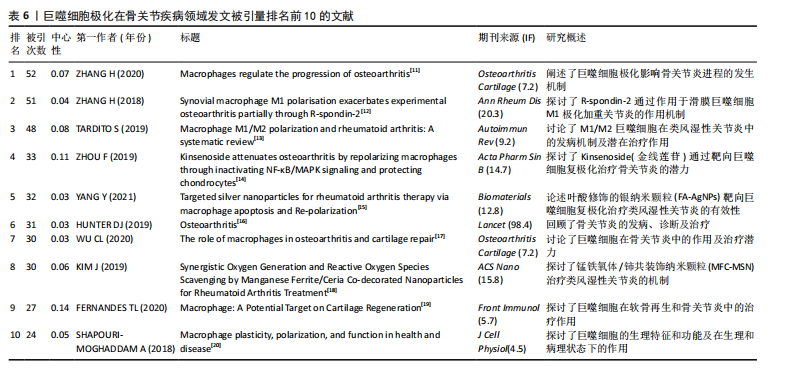
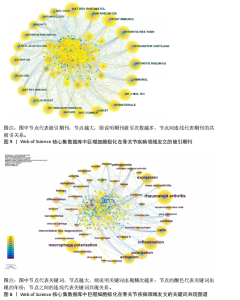
认为聚类结构显著,平均轮廓值(S) > 0.5可以认为聚类结构合理;平均轮廓值(S) > 0.7可以认为聚类是高效率且有说服力的。此研究基于关键词共现,采用对数似然比法(LLR)进行聚类,聚类模块值(Q)=0.704 7,平均轮廓值(S)=0.884,可以认为此研究集团结构显著,聚类令人信服。选取排名前5的聚类,具体见表9。聚类#0反映了巨噬细胞极化在动物模型和细胞实验方面的研究,聚类#1反映了M1型巨噬细胞极化的相关研究,聚类#2反映了巨噬细胞极化在滑膜组织中的相关研究,聚类#3反映了巨噬细胞极化相关的细胞因子与信号通路,聚类#4反映了巨噬细胞极化与特定疾病的相关性。 2.6.3 关键词时间线 基于关键词聚类的时间线可以清楚地观察不同聚类时间跨度。同一聚类的关键词节点按照时间顺序排列,越靠近右侧时间越接近;时间线越长,代表该聚类的研究持续时间越久。如图8所示,聚类#0 cells的时间跨度从2014年延续到2024年,是持续时间最长的聚类,说明该聚类标签已形成稳定的研究方向,是该领域研究的持续热点。 2.6.4 关键词突现分析 关键词突现是指关键词短时间内频次突然增加,可以反映某一时期内研究者对该领域的共同关注情况。如图9所示,其中突现强度最高的关键词是in vitro(离体),近5年突现值较高的关键词是inflammation(炎症)和regeneration (再生),说明这些关键词的研究方向可能是目前研究阶段的热点,代表着该领域的前沿内容。"
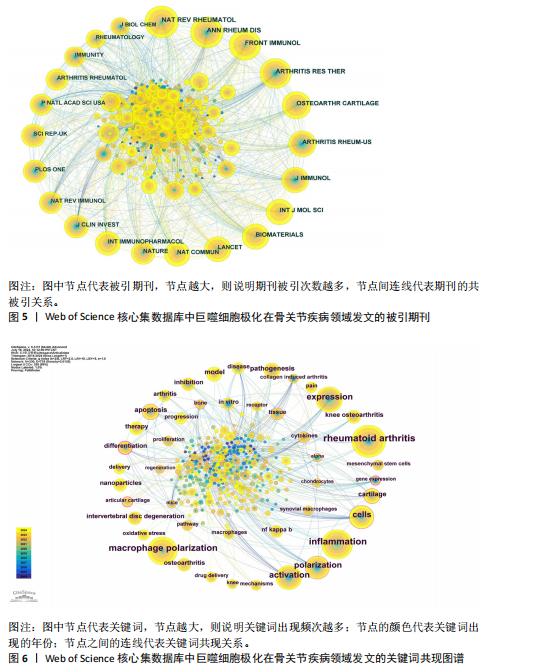
| [1] CAI L, LV Y, YAN Q, et al. Cytokines: The links between bone and the immune system. Injury. 2024;55(2):111203. [2] LUO M, ZHAO F, CHENG H, et al. Macrophage polarization: an important role in inflammatory diseases. Front Immunol. 2024;15:1352946. [3] MUÑOZ J, AKHAVAN NS, MULLINS AP, et al. Macrophage Polarization and Osteoporosis: A Review. Nutrients. 2020;12(10):2999. [4] HU K, SHANG Z, YANG X, et al. Macrophage Polarization and the Regulation of Bone Immunity in Bone Homeostasis. J Inflamm Res. 2023;16:3563-3580. [5] CHEN C. Searching for intellectual turning points: progressive knowledge domain visualization. Proc Natl Acad Sci U S A. 2004;101 Suppl 1(Suppl 1):5303-5310. [6] NINKOV A, FRANK JR, MAGGIO LA. Bibliometrics: Methods for studying academic publishing. Perspect Med Educ. 2022;11(3):173-176. [7] 沈爱宗,邵义伟,张圣雨,等.基于CiteSpace可视化分析我国医院智慧药学现状[J].中国药业,2023,32(7):1-8. [8] 魏锦强,曾宪中,曹学伟,等.基于CiteSpace的中医外治法治疗膝骨关节炎可视化分析[J].中医药导报,2021,27(8): 154-159,184. [9] MONDAL H, DEEPAK KK, GUPTA M, et al. The h-Index: Understanding its predictors, significance, and criticism. J Family Med Prim Care. 2023;12(11):2531-2537. [10] 刘祎如,葛莉,杨献军,等.基于CiteSpace的妊娠糖尿病饮食干预研究的文献计量学分析[J].广西医学,2021, 43(6):777-782. [11] ZHANG H, CAI D, BAI X. Macrophages regulate the progression of osteoarthritis. Osteoarthritis Cartilage. 2020;28(5):555-561. [12] ZHANG H, LIN C, ZENG C, et al. Synovial macrophage M1 polarisation exacerbates experimental osteoarthritis partially through R-spondin-2. Ann Rheum Dis. 2018; 77(10):1524-1534. [13] TARDITO S, MARTINELLI G, SOLDANO S, et al. Macrophage M1/M2 polarization and rheumatoid arthritis: A systematic review. Autoimmun Rev. 2019;18(11):102397. [14] ZHOU F, MEI J, HAN X, et al. Kinsenoside attenuates osteoarthritis by repolarizing macrophages through inactivating NF-κB/MAPK signaling and protecting chondrocytes. Acta Pharm Sin B. 2019;9(5): 973-985. [15] YANG Y, GUO L, WANG Z, et al. Targeted silver nanoparticles for rheumatoid arthritis therapy via macrophage apoptosis and Re-polarization. Biomaterials. 2021; 264:120390. [16] HUNTER DJ, BIERMA-ZEINSTRA S. Osteoarthritis. Lancet. 2019;393(10182):1745-1759. [17] WU CL, HARASYMOWICZ NS, KLIMAK MA, et al. The role of macrophages in osteoarthritis and cartilage repair. Osteoarthritis Cartilage. 2020;28(5):544-554. [18] KIM J, KIM HY, SONG SY, et al. Synergistic Oxygen Generation and Reactive Oxygen Species Scavenging by Manganese Ferrite/Ceria Co-decorated Nanoparticles for Rheumatoid Arthritis Treatment. ACS Nano. 2019;13(3):3206-3217. [19] FERNANDES TL, GOMOLL AH, LATTERMANN C, et al. Macrophage: A Potential Target on Cartilage Regeneration. Front Immunol. 2020;11:111. [20] SHAPOURI-MOGHADDAM A, MOHAMMADIAN S, VAZINI H, et al. Macrophage plasticity, polarization, and function in health and disease. J Cell Physiol. 2018;233(9):6425-6440. [21] TIAN H, QI H, XU X, et al. Research hotspots and trends in postlaparoscopic shoulder pain from 2003 to 2023: A bibliometric analysis. Heliyon. 2024;10(4):e25846. [22] LU Y, LIU L, PAN J, et al. MFG-E8 regulated by miR-99b-5p protects against osteoarthritis by targeting chondrocyte senescence and macrophage reprogramming via the NF-κB pathway. Cell Death Dis. 2021;12(6):533. [23] LIN R, YIN J, HUANG J, et al. Macrophage-derived ectosomal miR-350-3p promotes osteoarthritis progression through downregulating chondrocyte H3K36 methyltransferase NSD1. Cell Death Discov. 2024;10(1):223. [24] ZHANG J, RONG Y, LUO C, et al. Bone marrow mesenchymal stem cell-derived exosomes prevent osteoarthritis by regulating synovial macrophage polarization. Aging (Albany NY). 2020;12(24):25138-25152. [25] LI Z, WANG Y, LI S, et al. Exosomes Derived From M2 Macrophages Facilitate Osteogenesis and Reduce Adipogenesis of BMSCs. Front Endocrinol (Lausanne). 2021;12:680328. [26] RENDRA E, RIABOV V, MOSSEL DM, et al. Reactive oxygen species (ROS) in macrophage activation and function in diabetes. Immunobiology. 2019;224(2): 242-253. [27] FAN C, WANG W, YU Z, et al. M1 macrophage-derived exosomes promote intervertebral disc degeneration by enhancing nucleus pulposus cell senescence through LCN2/NF-κB signaling axis. J Nanobiotechnology. 2024;22(1):301. [28] ZHANG J, CHENG F, RONG G, et al. Circular RNA hsa_circ_0005567 overexpression promotes M2 type macrophage polarization through miR-492/SOCS2 axis to inhibit osteoarthritis progression. Bioengineered. 2021;12(1):8920-8930. [29] YANG X, CHANG Y, WEI W. Emerging role of targeting macrophages in rheumatoid arthritis: Focus on polarization, metabolism and apoptosis. Cell Prolif. 2020;53(7): e12854. [30] CUTOLO M, CAMPITIELLO R, GOTELLI E, et al. The Role of M1/M2 Macrophage Polarization in Rheumatoid Arthritis Synovitis. Front Immunol. 2022;13:867260. [31] WANG L, HE C. Nrf2-mediated anti-inflammatory polarization of macrophages as therapeutic targets for osteoarthritis. Front Immunol. 2022;13:967193. [32] CHENG H, CHAWLA A, YANG Y, et al. Development of nanomaterials for bone-targeted drug delivery. Drug Discov Today. 2017;22(9):1336-1350. [33] SUN J, DU J, LIU X, et al. Chondroitin sulfate-modified tragacanth gum-gelatin composite nanocapsules loaded with curcumin nanocrystals for the treatment of arthritis. J Nanobiotechnology. 2024;22(1):270. |
| [1] | Bao Zhuoma, Hou Ziming, Jiang Lu, Li Weiyi, Zhang Zongxing, Liu Daozhong, Yuan Lin. Effect and mechanism by which Pterocarya hupehensis skan total flavonoids regulates the proliferation, migration and apoptosis of fibroblast-like synoviocytes [J]. Chinese Journal of Tissue Engineering Research, 2026, 30(4): 816-823. |
| [2] | Zhang Yibo, Lu Jianqi, Mao Meiling, Pang Yan, Dong Li, Yang Shangbing, Xiao Xiang. Exploring the causal relationship between rheumatoid arthritis and coronary atherosclerosis: a Mendel randomized study involving serum metabolites and inflammatory factors [J]. Chinese Journal of Tissue Engineering Research, 2025, 29(在线): 1-9. |
| [3] | Li Jiagen, Chen Yueping, Huang Keqi, Chen Shangtong, Huang Chuanhong. The construction and validation of a prediction model based on multiple machine learning algorithms and the immunomodulatory analysis of rheumatoid arthritis from the perspective of mitophagy [J]. Chinese Journal of Tissue Engineering Research, 2025, 29(在线): 1-15. |
| [4] | Han Haihui, Ran Lei, Meng Xiaohui, Xin Pengfei, Xiang Zheng, Bian Yanqin, Shi Qi, Xiao Lianbo. Targeting fibroblast growth factor receptor 1 signaling to improve bone destruction in rheumatoid arthritis [J]. Chinese Journal of Tissue Engineering Research, 2025, 29(9): 1905-1912. |
| [5] | Liang Haobo, Wang Zeyu, Ma Wenlong, Liu Hao, Liu Youwen. Hot issues in the field of joint revision: infection, rehabilitation nursing, bone defect, and prosthesis loosening [J]. Chinese Journal of Tissue Engineering Research, 2025, 29(9): 1963-1971. |
| [6] | Lyu Liting, Yu Xia, Zhang Jinmei, Gao Qiaojing, Liu Renfan, Li Meng, Wang Lu. Bibliometric analysis of research process and current situation of brain aging and exosomes [J]. Chinese Journal of Tissue Engineering Research, 2025, 29(7): 1457-1465. |
| [7] | Xie Liugang, Cui Shuke, Guo Nannan, Li Aoyu, Zhang Jingrui. Research hotspots and frontiers of stem cells for Alzheimer’s disease [J]. Chinese Journal of Tissue Engineering Research, 2025, 29(7): 1475-1485. |
| [8] | Chang Jinxia, Liu Yufei, Niu Shaohui, Wang Chang, Cao Jianchun. Visualization analysis of macrophage polarization in tissue repair process [J]. Chinese Journal of Tissue Engineering Research, 2025, 29(7): 1486-1496. |
| [9] | Han Haihui, Meng Xiaohu, Xu Bo, Ran Le, Shi Qi, Xiao Lianbo. Effect of fibroblast growth factor receptor 1 inhibitor on bone destruction in rats with collagen-induced arthritis [J]. Chinese Journal of Tissue Engineering Research, 2025, 29(5): 968-977. |
| [10] | Wang Yuru, Li Siyuan, Xu Ye, Zhang Yumeng, Liu Yang, Hao Huiqin. Effects of wogonin on joint inflammation in collagen-induced arthritis rats via the endoplasmic reticulum stress pathway [J]. Chinese Journal of Tissue Engineering Research, 2025, 29(5): 1026-1035. |
| [11] | Li Huijun, Li Huangyan, Zhang Yeting. Physical activity and cognition in older adults: research hotspot and topic evolution [J]. Chinese Journal of Tissue Engineering Research, 2025, 29(5): 1073-1080. |
| [12] | Dang Xiaowen, Huang Hailiang, Huang Lei, Wang Yajie . Research frontiers and hotspots of carbon nanomaterials in biomedical field over the past 10 years [J]. Chinese Journal of Tissue Engineering Research, 2025, 29(4): 752-760. |
| [13] | Wang Xuepeng, , He Yong, . Effect of insulin-like growth factor family member levels on inflammatory arthritis: a FinnGen biobank-based analysis [J]. Chinese Journal of Tissue Engineering Research, 2025, 29(35): 7656-7662. |
| [14] | Wang Tao, Wang Shunpu, Min Youjiang, Wang Min, Li Le, Zhang Chen, Xiao Weiping. Causal relationship between gut microbiota and rheumatoid arthritis: data analysis in European populations based on GWAS data [J]. Chinese Journal of Tissue Engineering Research, 2025, 29(35): 7663-7668. |
| [15] | Ma Yucong, Ouyang Zhengzheng, Liu Xiaojie, Yang Sifei. Tracking of research trends and hotspots in medical magnesium alloy materials [J]. Chinese Journal of Tissue Engineering Research, 2025, 29(34): 7470-7480. |
| Viewed | ||||||
|
Full text |
|
|||||
|
Abstract |
|
|||||
